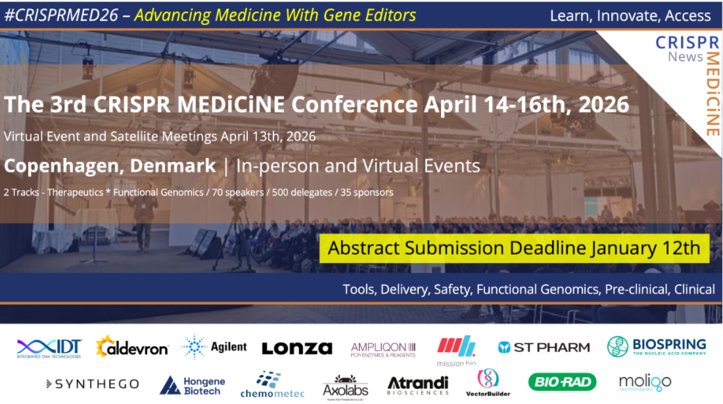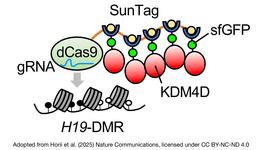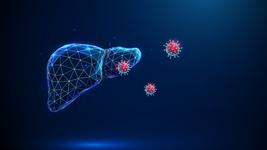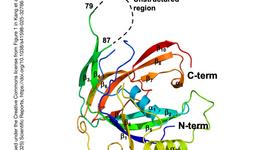CRISPRMED25 Poster Prize Winners Highlight Diverse Advances in CRISPR Medicine
CMN Intelligence - The World’s Most Comprehensive Intelligence Platform for CRISPR-Genomic Medicine and Gene-Editing Clinical Development
Providing market intelligence, data infrastructure, analytics, and reporting services for the global gene-editing sector. Read more...

At the CRISPR Medicine Conference 2025 (CRISPRMED25) held in Copenhagen earlier this month, four researchers were recognised for their outstanding poster presentations. The winning posters highlighted a diverse range of advances in the gene-editing field, from new technical insights about how epigenetics influence safety in gene editing to innovative T-cell engineering methods, legal frameworks for equitable access, and novel therapeutic approaches to thalassaemia.
CRISPR Medicine News spoke with the four prize winners to learn more about their research.
Eve Stalker: Epigenetic features influencing Cas9-mediated translocations
Eve Stalker, PhD student at University of Cambridge (UK), won 1st prize for her poster entitled: "Identifying epigenetic features that influence Cas9-mediated translocations."
Her work, which is carried out in collaboration with MRC Toxicology Unit (also at University of Cambridge) and AstraZeneca, aims to better understand how the epigenome influences Cas9-mediated chromosomal translocations – a critical safety concern for gene-editing therapies. The research specifically focuses on identifying regions that are prone to translocation and mapping these against epigenetic markers to understand the interplay between the epigenome and the translocation events.
Using CAST-seq, which was developed by Toni Cathomen’s team at University of Freiburg in 2021, Stalker quantified chromosomal aberrations from both on-target and off-target Cas9 activities and analysed them alongside ChIP-seq data collated by the ENCODE consortium. The findings revealed that several histone marks associated with open chromatin and transcriptional start sites may predict Cas9-mediated translocations. Of note, the histone modification H3K4me1, which was previously linked with chromosomal translocations in haematological malignancies, was significantly enriched in translocated regions compared to predicted off-target sites based on sgRNA sequence similarity.
After the conference, we asked Eve a few questions about the broader impact of her work:
- How might your discoveries about epigenetic features change our approach to CRISPR safety assessment in clinical applications?
My research aims to develop predictive tools to better understand off-target sgRNA binding and CRISPR-mediated translocations. By using CAST-seq and publicly available histone ChIP-seq data, I investigated whether certain epigenetic features influence on-target/off-target translocation events. I found that euchromatin and the histone modification H3K4me1 appear to be causal in these translocation events. Incorporating these features into prediction tools could help us better estimate off-target consequences. By gaining a deeper understanding of how the epigenome interacts with Cas9 binding and subsequent DNA repair pathways, we can determine whether these factors should be included in our safety assessments.
- How might the variability of the human epigenome across populations affect the predictability of Cas9-mediated translocations?
The variability in the human epigenome across individuals, tissues, and disease states can significantly impact the predictability of Cas9-mediated translocations. Since gene editors interact directly with DNA, it is highly likely that they also interact with epigenetic modifications. This variability could lead to differences in off-target effects and translocation events, making it challenging to predict outcomes uniformly across diverse populations.
- What do you see as the biggest challenge in translating epigenomic insights into gene-editing therapies?
The biggest challenge here is characterising the dynamic nature of the epigenome. The epigenome is highly responsive to environmental changes, making it difficult to characterise consistently. The degree of epigenetic changes across an individual's lifetime, or even within a single day, adds to this complexity. A potential solution could be focusing on the epigenetic code, which suggests that certain patterns of epigenetic modifications work together to perform specific functions and may exhibit increased stability. Ultimately, understanding the mechanisms driving these biological processes is crucial for predicting the safety of new gene-editing therapies.
- How might personalised medicine incorporate epigenetic profiling to improve CRISPR outcomes?
Personalised medicine, particularly in gene therapy development, is increasingly adopting a tailored approach to patient screening. Individual single nucleotide polymorphisms are being identified as factors influencing the efficiency and off-target effects of gene editors. If the epigenome proves to be a key factor in undesirable outcomes, it will be essential to understand an individual's epigenome. Incorporating epigenetic profiling into personalised medicine could enhance the precision and safety of CRISPR-based therapies by accounting for individual epigenetic variations.
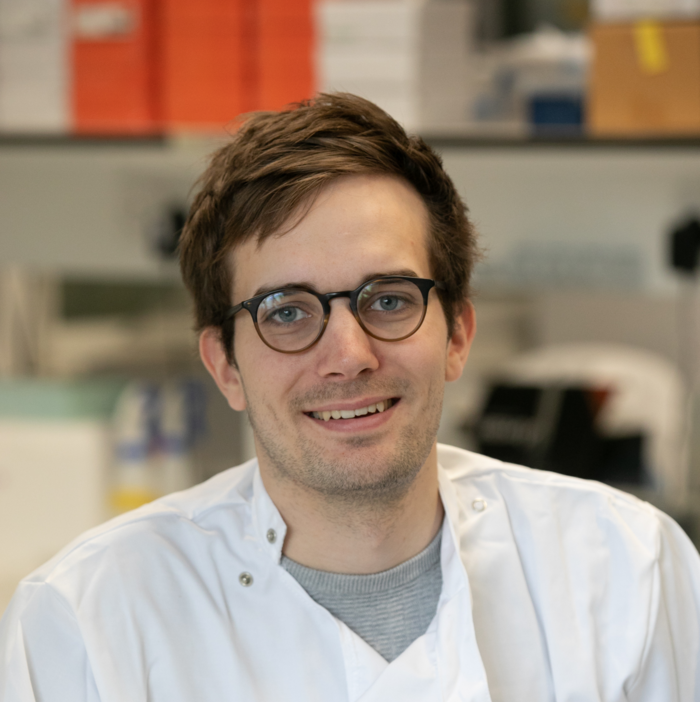
Kristoffer Haurum Johansen: Enhanced expansion of CRISPR-modified T cells
Kristoffer Haurum Johansen, Postdoc at Technical University of Denmark, received the 2nd prize for his poster: "Antigen-scaffold-mediated expansion of CRISPR CAR- and TCR-T cells generates highly enriched, efficacious T-cell products."
His research addresses key challenges in engineering T cells for cancer immunotherapy through non-viral delivery of receptors using CRISPR/Cas9. Johansen, who works in the T-cells and Cancer group at the Experimental and Translational Immunology Section, Department for Health Technology, Technical University of Denmark, optimised protocols for effective TCR knockin using closed-circular DNA and various small molecule inhibitors, achieving approximately 20% knockin efficiency. When the team adapted an existing protocol using antigen-presenting scaffolds (Ag-scaffolds) for T cell expansion, they achieved over 90% antigen-specific cells after 14 days of in vitro culture. Both in vitro and in vivo experiments demonstrated that Ag-scaffold expanded cells were significantly more effective at killing target cells than conventionally expanded cells.
Following his presentation, Kristoffer discussed with us how his technology might reshape the landscape of cell-based immunotherapies:
- How do you envision your antigen-scaffold technology could transform cell-based immunotherapies in the next 5-10 years?
We adapted the antigen-scaffold technology for genetically-modified T cells and found that it is a robust and flexible tool for generating T cell receptor (TCR)- or chimeric antigen receptor (CAR)-modified T cells. A distinct advantage of our antigen-scaffolds compared to similar technologies is the ease of assembly, enabling straightforward retargeting to various CARs or TCRs, as well as simple customisation of costimulatory signals. This flexibility facilitates adaptation to GMP-compliant clinical-scale production. I therefore expect that within the next 5–10 years, antigen-scaffold technology or derivatives thereof will become standard tools in clinical-grade TCR or CAR production.
- What potential applications beyond cancer treatment do you see for your CRISPR-engineered T cell approach?
Currently, TCR- and CAR-T cell therapies primarily target cancer; however, there's increasing interest in applying these approaches for autoimmune and inflammatory conditions. For instance, engineered regulatory T cells (Tregs) could be redirected to suppress inflammation in autoimmune diseases. Similarly, CD19-targeted CAR-T cells can effectively deplete pathogenic B cells in autoimmune conditions such as systemic lupus erythematosus. Additionally, CRISPR-engineered T cells hold potential for treating chronic viral infections, inducing transplant tolerance, combating allergies, and even addressing certain neurodegenerative disorders. Importantly, the modularity and versatility of our antigen-scaffold approach enables rapid customisation for diverse therapeutic targets, significantly enhancing precision and therapeutic flexibility beyond oncology.
- What do you believe are the most significant barriers to wider adoption of non-viral CRISPR delivery methods?
The challenges for non-viral CRISPR delivery for knockins are still a lack of efficiency and viability when inserting large DNA fragments, as well as the risk of genetic instability/aberrations. However, non-viral delivery has come a long way, and with optimised delivery and template modality, efficiency can be markedly increased ex vivo. Nonetheless, for T cells, yield is not everything; the phenotype is crucial. Our antigen-scaffolds solve both challenges – yield as well as simultaneously fine-tuning the phenotype. Non-viral in vivo delivery is also taking large strides towards feasibility in the clinic, but there are still major challenges regarding the efficient knockin of large cargo such as 2-3 kb CARs and TCRs.

Franziska Bächler: Democratising access to CRISPR
Franziska Bächler, Legal Scholar at University of Basel, Switzerland, was awarded the 3rd prize for her poster: "Democratizing CRISPR in its public-private ecosystem."
Bächler's work stands out for addressing a critical non-technical dimension of CRISPR technology: equitable access within complex legal frameworks. Her poster highlights the challenges within the current patent and licensing ecosystem that may hinder the democratisation of CRISPR technology. In her work, Bächler evaluates how the right to science could serve as an alternative normative framework to traditional mechanisms such as patent exceptions and licensing, ensuring that CRISPR advances are used responsibly and for society's collective benefit.
Bächler provided insights on several key questions regarding the legal and ethical frameworks surrounding CRISPR technology:
- How can we balance innovation in CRISPR technology with ensuring its benefits are equitably distributed globally?
When we talk about the equitable distribution of CRISPR, we need to remember that it is not just about access to CRISPR-based therapies for patients in need, but also about access to technology and research tools, such as infrastructure, equipment and expertise.
There are several successful initiatives to disseminate CRISPR tools. However, the accentuated patent situation, the patent thickening and the royalty stacking in the field, as well as the exclusive licensing schemes for somatic applications, are concerning factors for the widespread dissemination of the technology. These factors are fundamentally rooted in the patent and licensing system as we know it, with its considerable advantages and its primary objective of promoting innovation. Thereby, we need to recognise the highly unusual situation of 5 competing patent portfolios arising from the fact that more or less identical inventions have been made almost simultaneously by 5 groups.
Accordingly, when we turn to the challenge of how to balance innovation in CRISPR technology with ensuring that its benefits are equitably distributed, we need to discuss whether the current patent and licensing system is fulfilling its function of fostering innovation or, at a certain point, is actually hindering innovation. Existing legal instruments to ensure access to CRISPR inventions (e.g., research exceptions or patent pools) are limited in their effectiveness. This is particularly true as their scope either does not apply to technology used as a tool or the instruments are unlikely to be successful in public-private ecosystems. We may therefore need to discuss new legal instruments to ensure access to cutting-edge technologies, such as a reinterpreted right to science. As the right to science has never been legally defined, several aspects need to be considered, such as the substantive scope of protection. The interpretation of the terms 'science', 'scientific progress' and 'its applications' is at the heart of the right to science. Given the diversity of actors in the CRISPR ecosystem, the subjective scope of the right to science would likely need to extend to both public and private actors. Proposals for the enforcement of the right remain to be fleshed out.
- What role should international organisations play in establishing frameworks for CRISPR access and regulation?
As only a global approach can be successful, cooperation with and between international organisations such as WHO and World Intellectual Property Organization (WIPO) is very important. It is also important that the owners of CRISPR patents are included in the dialogue, ensuring that all key stakeholders are actively involved in shaping a responsible and forward-looking framework for its applications.
- How might different cultural and ethical perspectives shape the democratisation of CRISPR technology?
Ethical aspects of gene editing are also raised in the literature and discussions. One such ethical issue is the blurred line between prevention and enhancement. Such cultural and ethical issues are relevant not only to the democratisation of CRISPR technology, but also to the pace of innovation.
Another aspect is that certain populations are reluctant to accept gene therapy for cultural or historical reasons. For example, despite the democratisation of CRISPR, it is conceivable that CRISPR-based treatments would not be successfully applied in African countries. Involvement of local researchers, education and success stories seem to be promising measures to increase acceptance and adaptation of the technology among the population.
These cultural and ethical concerns related to somatic gene editing must be distinguished from the ethical discourse surrounding human germline gene editing. The literature on the ethical concerns of human germline gene editing is extensive and discusses a variety of normative positions.
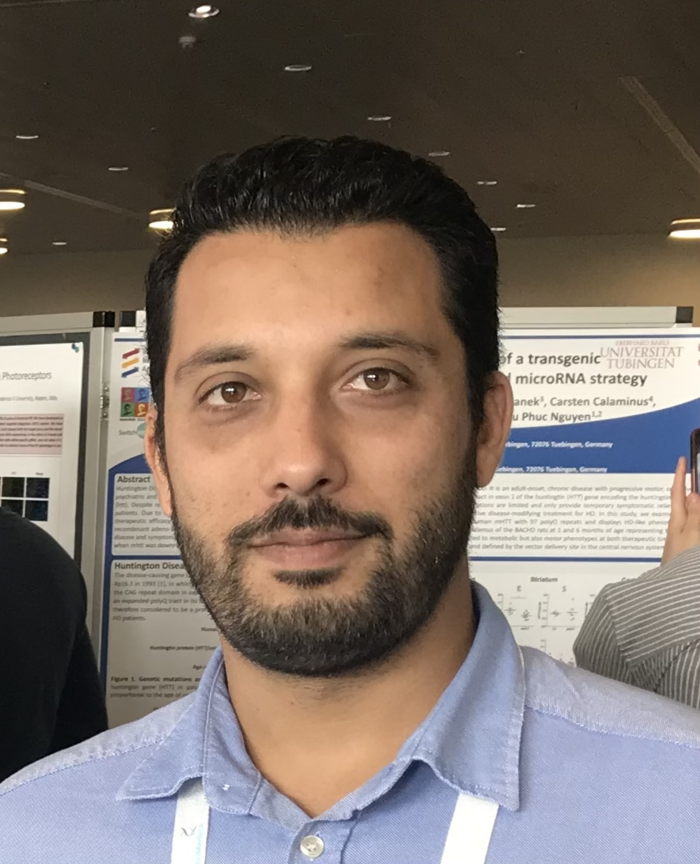
Petros Patsali: CRISPR approaches for thalassaemia
Petros Patsali, Associate Scientist (Department of Molecular Genetics Thalassemia, The Cyprus Institute of Neurology and Genetics), received the 4th prize for his poster: "Preclinical validation of CRISPR/Cas genome editing approaches as advanced therapy for HBBIVSI-110(G>A) thalassaemia."
Patsali's research targets β-Thalassemia, which is caused by deficient β-globin production and arises through mutations in the HBB gene. Specifically, his work focuses on the HBBIVSI-110(G>A) mutation, which has a high carrier frequency in Cyprus (76%) and many EU countries. His poster presented two distinct CRISPR-based approaches: a CRISPR/Cas9 RNA-guided nuclease (IVSI-110 RGN) and a nearly PAM-less SpG Adenine Base Editor (SpG7 ABE). Both methods effectively disrupt abnormal splicing elements in the mutated HBB gene, achieving clinically relevant efficiencies in patient-derived cells.
The project evaluated edited cells both in vitro and in vivo using chimeric mice engineered to facilitate human haematopoietic stem cells engraftment without irradiation. Results showed high on-targeting efficiency (RGN 85%; ABE ~40% at key positions) with undetected off-targeting. Edited cells demonstrated normalised HBB/HBA ratios without compromising stem cell potential. Current data indicates the ABE SpG7 approach as most promising for clinical application, achieving therapeutic levels while maintaining long-term repopulation capacity of the edited cells.
This collaborative research involves multiple institutions including The Cyprus Institute of Neurology and Genetics, the Gene and Cell Therapy Center/Hematology-Hematopoietic Cell Transplantation Unit at George Papanicolaou Hospital in Thessaloniki, the Aristotle University of Thessaloniki, University of Freiburg, the Thalassemia Centre - Cyprus Ministry of Health and Gene & Cell Ltd in London.
Petros spoke with us about how his mutation-specific CRISPR approaches compare to universal techniques, the broader impact of such precision therapies on treating genetic diseases, and the most promising future directions for CRISPR in blood disorders
- How do your mutation-specific approaches compare to the universal BCL11A erythroid enhancer targeting approach in terms of long-term clinical potential?
Our mutation-specific approaches which directly target the HBBIVSI-110(G>A) mutation using either a CRISPR/Cas9 nuclease (IVSI-110 gRNA) or an adenine base editor (ABE SpG7) show distinct advantages compared to the universal BCL11A erythroid enhancer targeting strategy (sg1617 gRNA) for long-term clinical potential. While both mutation-specific tools demonstrated high on-target editing efficiency in vitro, leading to the restoration of normal β-globin levels, the ABE SpG7 base editor exhibited particularly promising characteristics for long-term engraftment. In contrast to both CRISPR/Cas9 nuclease-based approaches (IVSI-110 gRNA and sg1617), ABE SpG7 base editing resulted in stable or even increased levels of genome editing in long-term repopulating haematopoietic stem cells (HSCs) within the bone marrow of primary NBSGW recipient mice. This superior long-term performance is likely attributed to the double-strand break (DSB)-free mechanism of base editing, which imposes less stress on the cells, thereby helping to maintain their long-term repopulating capacity. Furthermore, mutation-specific therapy holds significant therapeutic potential for β-thalassemia, as even monoallelic correction can potentially elevate β-globin production to levels seen in asymptomatic carriers, thus achieving a therapeutic benefit. This contrasts with the BCL11A erythroid enhancer targeting approach, where biallelic disruption is generally required to induce sufficiently high levels of foetal haemoglobin. Consequently, the potentially higher efficiency of mutation-specific tools like ABE SpG7, combined with the sufficiency of monoallelic correction, suggests they could be safer. Achieving therapeutic levels might require lower amounts of the editing tool, which could translate to reduced cellular toxicity, lower risks of off-target editing, and potentially lower production costs.
- What broader impact could mutation-specific gene therapies have on treating genetic diseases beyond thalassemia?
Mutation-specific gene therapies, such as those developed in our research targeting the HBBIVSI-110(G>A) mutation, hold substantial promise for treating a wide array of genetic diseases beyond thalassemia, particularly monogenic disorders caused by defects in a single gene. Unlike approaches that rely on indirect compensatory mechanisms, these therapies aim to directly correct the specific genetic lesion underlying the disease. This precision offers the potential to restore normal gene function, paving the way for more complete and potentially curative treatments. Advanced technologies like base editing, exemplified by the SpG7 ABE tool used in our study, are especially advantageous because they can correct specific point mutations without inducing DSBs, thereby avoiding the risks associated with unintended insertions or deletions (indels). The successful development and refinement of such mutation-specific strategies could therefore revolutionise the treatment landscape for numerous inherited conditions affecting various tissues and organs, contingent upon identifying the causative mutation, ensuring it is targetable, and achieving efficient delivery of the therapeutic tool to the relevant cell types.
- What do you see as the most promising direction for CRISPR therapies for genetic blood disorders in the coming decade?
The most promising direction for CRISPR-based therapies for genetic blood disorders in the coming decade appears to be the advancement of precise genome-editing methods that function without inducing DSBs. While base editing excels at correcting point mutations, as demonstrated by our ABE SpG7 tool, the field is actively pushing towards technologies like prime editing. The goal is to efficiently and specifically correct a broader range of mutations, including larger deletions or insertions, in a DSB-free manner. Currently, many promising therapeutic strategies, validated preclinically or already in clinical trials for various blood disorders, rely on an ex vivo approach. This involves isolating the patient's HSCs, editing them in the lab, and performing safety and efficacy assessments before autologous transplantation back into the patient. This ex vivo process offers significant advantages in terms of control and safety. However, it comes with considerable drawbacks, including the high cost of the overall treatment and the potential risks and toxic side effects associated with the necessary myeloablative conditioning regimens required to clear bone marrow space for the transplanted cells. Therefore, a major shift is anticipated towards in vivo genome editing. This paradigm involves delivering the editing tools directly into the patient's bloodstream, using sophisticated delivery vehicles such as lipid or peptide-based nanoparticles or engineered virus-like particles. These vehicles would be designed to specifically target HSCs within the bone marrow niche, delivering the editing machinery for direct correction in situ. Achieving high efficiency and specificity with minimal off-target editing in other tissues remains a challenge, but successfully developing in vivo HSC editing would likely significantly reduce the overall cost and complexity of these therapies, making them accessible to many more patients suffering from genetic blood disorders.
Congratulations once again to our four poster winners!
More about CRISPRMED25
You can view all of the CRISPRMED25 abstracts here, or you can download them here. Read our other CRISPRMED25 coverage here.
To get more CRISPR Medicine News delivered to your inbox, sign up to the free weekly CMN Newsletter here.
Tags
CLINICAL TRIALS
Sponsors:
Base Therapeutics (Shanghai) Co., Ltd.
Sponsors:
Base Therapeutics (Shanghai) Co., Ltd.

